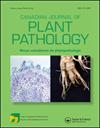红疫霉分离株毒力和甲霜灵-m敏感性的多样性对树莓根腐病和萎蔫复合物的管理具有启示意义
IF 1.5
4区 农林科学
Q3 PLANT SCIENCES
引用次数: 1
摘要
摘要覆盆子根腐病(RRWC)是加拿大覆盆子生产中最重要的病害,主要由疫霉(Phytophthora rubi)引起。目前几乎没有关于影响加拿大覆盆子的红斑假单胞菌分离株的表型多样性或对甲酰基-m的敏感性的信息。本研究旨在了解2018-2020年不同覆盆子品种、不同田地和不同地点的覆盆子P. rubi种群的毒力多样性和对甲氨苄的敏感性。所有分离株(n = 24)对‘Chemainus’覆盆子均具有致病性,并且在发病进展曲线(rAUDPC)下的相对面积上,对第一叶症状发展(DFSD)的天数和萎蔫指数的进展有显著差异(P < 0.05)。主成分分析表明,根腐病指数、rAUDPC、DFSD以及根长和根重减少百分比是评估病原菌毒力的重要变量。采用径向生长试验评估了甲氨酰基-m的敏感性,并测定了44株菌株抑制50%菌丝生长的有效浓度(EC50)。EC50值为0.035 ~ 4.71µg mL−1,平均值为0.793µg mL−1。约61%的分离株对甲酰基-m非常敏感(EC50值<0.20µg mL - 1), 25%的分离株对甲酰基-m敏感(EC50值为0.21 ~ 1.18µg mL - 1), 14%的分离株对甲酰基-m敏感性降低(EC50值范围为1.19 ~ 4.71µg mL - 1)。了解病原菌表型多样性将有助于树莓育种者筛选抗RRWC的基因型,而杀菌剂敏感性研究的结果将有助于制定RRWC的管理策略。本文章由计算机程序翻译,如有差异,请以英文原文为准。
Diversity in virulence and metalaxyl-m sensitivity of Phytophthora rubi isolates has implications for raspberry root rot and wilting complex management
Abstract Raspberry root rot and wilting complex (RRWC), primarily caused by Phytophthora rubi, is the most important disease for raspberry producers in Canada. There is currently little to no information on phenotypic diversity or sensitivity to metalaxyl-m of P. rubi isolates affecting raspberries in Canada. This study was conducted to understand the diversity in virulence and sensitivity to metalaxyl-m of P. rubi populations collected from diverse raspberry cultivars, fields, and locations during 2018–2020. All isolates of P. rubi (n = 24) were pathogenic on ‘Chemainus’ raspberry and showed significant variation (P < 0.05) in days to first foliar symptom development (DFSD) and progress in wilting index, as indicated by relative areas under disease progress curves (rAUDPC). Principal component analyses identified that root rot index, rAUDPC, DFSD, and percentage reduction in root length and weight were important variables in assessing pathogen virulence. Metalaxyl-m sensitivity was assessed using a radial growth assay and effective concentrations that inhibited 50% of mycelial growth (EC50) were determined for 44 isolates. The EC50 values ranged from 0.035–4.71 µg mL−1 with a mean value of 0.793 µg mL−1. About 61% of the isolates were very sensitive (EC50 values <0.20 µg mL−1), 25% of isolates were considered sensitive (EC50 values of 0.21–1.18 µg mL−1), and 14% of isolates showed reduced sensitivity to metalaxyl-m (EC50 value range of 1.19–4.71 µg mL−1). Knowledge of pathogen phenotypic diversity will be useful for raspberry breeders in screening genotypes against RRWC and the results of the fungicide sensitivity study will be useful in developing management strategies for RRWC.
求助全文
通过发布文献求助,成功后即可免费获取论文全文。
去求助
来源期刊
CiteScore
4.50
自引率
5.00%
发文量
56
审稿时长
6-12 weeks
期刊介绍:
Canadian Journal of Plant Pathology is an international journal which publishes the results of scientific research and other information relevant to the discipline of plant pathology as review papers, research articles, notes and disease reports. Papers may be submitted in English or French and are subject to peer review. Research articles and notes include original research that contributes to the science of plant pathology or to the practice of plant pathology, including the diagnosis, estimation, prevention, and control of plant diseases. Notes are generally shorter in length and include more concise research results. Disease reports are brief, previously unpublished accounts of diseases occurring on a new host or geographic region. Review papers include mini-reviews, descriptions of emerging technologies, and full reviews on a topic of interest to readers, including symposium papers. These papers will be highlighted in each issue of the journal and require prior discussion with the Editor-in-Chief prior to submission.

 求助内容:
求助内容: 应助结果提醒方式:
应助结果提醒方式:


